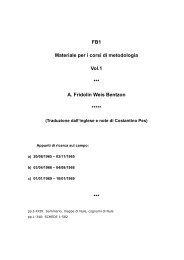XI Rassegna - Nuoro 7/12 Ottobre 2002 [file.pdf] - Isre
XI Rassegna - Nuoro 7/12 Ottobre 2002 [file.pdf] - Isre
XI Rassegna - Nuoro 7/12 Ottobre 2002 [file.pdf] - Isre
You also want an ePaper? Increase the reach of your titles
YUMPU automatically turns print PDFs into web optimized ePapers that Google loves.
74<br />
T his documentary is about a feast in honour of St<br />
Joseph, widespread throughout all Sicily, that is<br />
characterised by offering the poor and orfans a dinner<br />
and the preparation of bread which is given as a gift.<br />
According to the great Sicilian folklorist, Giuseppe Pitrè<br />
“this banquet is offered by people as a means of giving<br />
thanks … as it is a homage to the Father of Providence,<br />
everything must be grand and spectacular”.<br />
Ferrara made this film in Gela which was undergoing a<br />
great social and economic transformation at the time, due<br />
to the construction of large scale petrochemical<br />
installations there, this transformation became the theme<br />
of another of his documentaries made in the same town<br />
and year, Gela antica e nuova.<br />
In an interview broadcast two years ago, the director<br />
recalled that: “For St Joseph, the people of Gela<br />
organised a feast of extraordinary proportions with<br />
charitable aims in mind: some ten families prepared three<br />
characters chosen from the poorest families of the place,<br />
a small child, and old man and a young girl who<br />
represented the sacred family. They dressed them in white<br />
tunics and placed crowns on their heads made from multi<br />
coloured paper. On that occasion all the well-off families<br />
competed with each other to have them as their guests. In<br />
the central church about a hundred St Josephs, Baby<br />
Jesus and little Virgin Marys were first blessed and then<br />
went off to celebrate the feast consuming suppers of truly<br />
pantagruelian proportions, which had been prepared. At<br />
the end of the feast the leftovers were distributed among<br />
the poor families, who thus had enough to feed<br />
themselves with for a week”.<br />
Biofilmography<br />
Giuseppe Ferrara was born<br />
in 1932 in Castelfiorentino, in<br />
Tuscany. After graduating<br />
from the University of Florence<br />
with a degree in Literature,<br />
including a thesis on the<br />
history of cinema, he began<br />
working as a free-lance<br />
cinema journalist in 1952. In<br />
1959 he obtained a Diploma<br />
in film direction from the<br />
Centro Sperimentale di<br />
Cinematografia in Rome. He<br />
has made about eighty<br />
cinema documentaries as well<br />
as published numerous works<br />
on the subject of the cinema.<br />
His name is associated with<br />
the important season of Italian<br />
documentary films called<br />
“Demartiniano”, after the<br />
famous ethnologist Ernesto De<br />
Martino (from the end of the<br />
1950s up until the first years<br />
of the 1970s). Dealing with<br />
De Martino’s study and<br />
research themes (funeral<br />
lament, magic rituals,<br />
tarantism) and the great<br />
festivals of the South, the work<br />
of a group of directors,<br />
Gandin, Mingozzi, Di<br />
Gianni, Dal Fra and Mangini,<br />
and last but not least Ferrara,<br />
produced a series of<br />
documentaries that for many<br />
academics marked the birth<br />
of Italian ethnographic<br />
cinema. Of Ferrara’s<br />
documentaries related to this<br />
theme one recalls: I maciari<br />
(1962), about the<br />
thaumaturgical powers of a<br />
child wizard, Il ballo delle<br />
vedove (1962), filmed in<br />
Sardinia at Lula and centred<br />
on the rituals surrounding the<br />
healing of a man bitten by a<br />
black widow spider<br />
(Sardinian tarantism); La<br />
madonna di Gela and La<br />
cena di San Giuseppe both<br />
filmed in Gela in Sicily in<br />
1963, that deal with themes<br />
of popular religion in southern<br />
Italy. Ferrara has also made<br />
thirteen full length films all<br />
centred on political, social<br />
and current themes of public<br />
debate. The most well known<br />
of these are: Il sasso in bocca<br />
(1970); Cento giorni a<br />
Palermo (1982); Il caso Moro<br />
(1986); Giovanni Falcone<br />
(1993); I bancheri di Dio - Il<br />
caso Calvi (<strong>2002</strong>).<br />
75


![XI Rassegna - Nuoro 7/12 Ottobre 2002 [file.pdf] - Isre](https://img.yumpu.com/14942985/39/500x640/xi-rassegna-nuoro-7-12-ottobre-2002-filepdf-isre.jpg)

![Folclore e filosofia - di G. Baratta [file.pdf] - Isre](https://img.yumpu.com/16085183/1/184x260/folclore-e-filosofia-di-g-baratta-filepdf-isre.jpg?quality=85)